Saturday, November 20, 2004
Silent America
Billon antoninianus, Gallienus, Rome, Göbl 41v
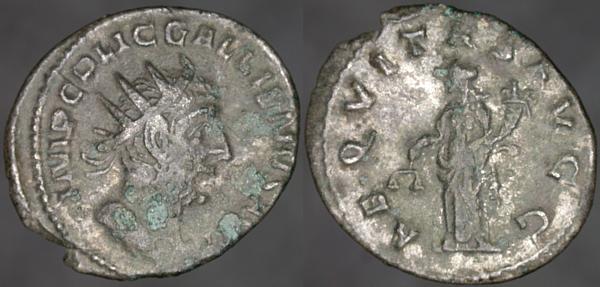
IMP C P LIC GALLIENVS AVG, Radiate cuirassed bust right | AEQVITAS AVGG, Aequitas standing facing, head left, holding cornucopia right and scales left.
The portrait is very unusual, but this is a very early coin of Gallienus. One of the things we don't know about Roman coins is how the engravers were made aware of the emperor's appearance. It's not uncommon for the first coins of a new emperor to use his name in conjunction with a portrait like that of the previous emperor, or a portrait that looks unlike those later seen for the same man.
This might be an attempt based on word of mouth or guesswork.
Friday, November 19, 2004
Æ24, Heliopolis in Coele-Syria, Valerian, ...
Lindgren III, 1283var
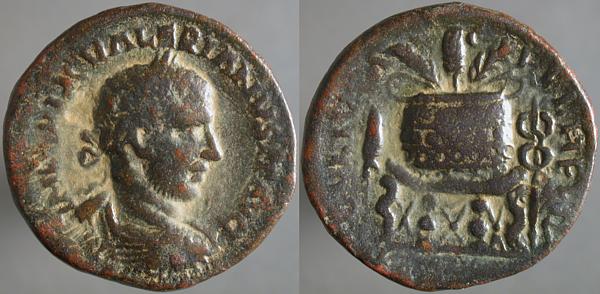
IMP LIC VALERIANVS [?] AVG, Laureate draped cuirassed bust right | COL IVL A_V_G_FEL HEL V, Prize crown with protruding palm, grain ear, and poppy on ornate table, cauduceus right, thyrsus? left.
Another of the many coins that Heliopolis issued with a prize theme, announcing or commemorating games held there. This one doesn't explicitly state that these were sacred iselastic games, open to all, and may be for different games than the others I have.

IMP LIC VALERIANVS [?] AVG, Laureate draped cuirassed bust right | COL IVL A_V_G_FEL HEL V, Prize crown with protruding palm, grain ear, and poppy on ornate table, cauduceus right, thyrsus? left.
Another of the many coins that Heliopolis issued with a prize theme, announcing or commemorating games held there. This one doesn't explicitly state that these were sacred iselastic games, open to all, and may be for different games than the others I have.
Thursday, November 18, 2004
"there are hopes a new museum will be built"
Silvered Æ antoninianus, Gallienus, Rome, Göbl 569w
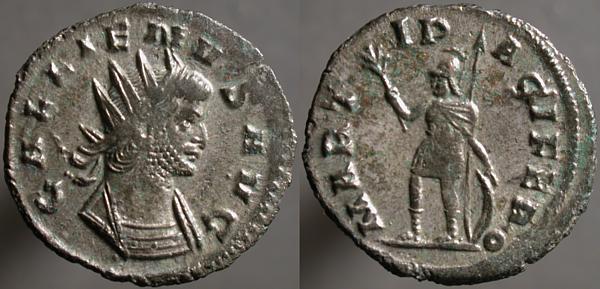
GALLIENVS AVG, Radiate cuirassed bust right | MARTI PACIFERO, Mars standing facing, head left, holding branch left and spear right, leaning on shield right.
This reverse theme, of Mars the Peacemaker, is most commonly seen as here, with a simple radiate head on the obverse, and the "A" mark of the first officina in the reverse left field, and far less frequently with a cuirassed bust and no field mark.
If the difference strikes you as interesting and significant, you may have what it takes to collect ancients. This may explain why it's not a particularly popular hobby and why, having been blogging for over a year now, I still haven't inspired collectors who are better writers to take up the habit.
Which was kinda the whole point.
Still, virtue's its own reward and all that.
Wednesday, November 17, 2004
AR unit, Mauryan Empire, Gupta-Hardaker 589
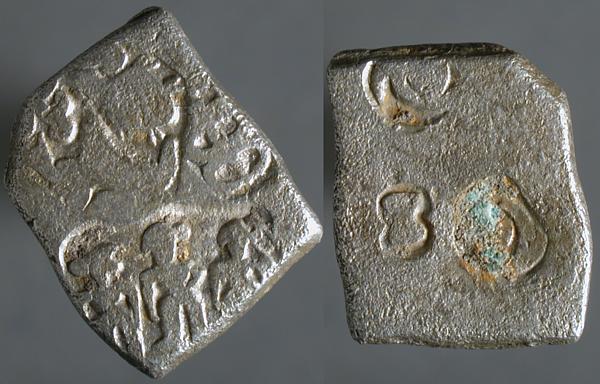
Various punches, one featuring three human forms, above them perhaps a turtle | Various banker's punches.
As much as it's a good idea for a collector to specialize, few are ready to do so from their first day, and most collectors, when they find their area of interest, find that they've got some stuff that just doesn't fit. This is one such piece.
While Alexander the Great invaded India, he was largely foiled in conquering it, and most of India soon came under the control of Chandragupta Maurya.
The minting technique was unusual: large sheets of silver were poured, various punchmarks were applied to one face, the silver cut to just larger than the right size, and the individual coins adjusted to correct weight by removing material as needed. The coins tend to be rectangular, since that's by far the easiest shape to chisel out of a large sheet.
Tuesday, November 16, 2004
Æ25, Nicomedia in Bithynia, Gallienus, SNG von Aulock 7143
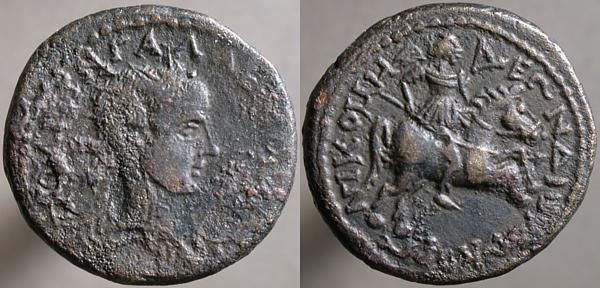
[Π]Ο ΛΙ ΕΓΝ ΓΑΛΛ[ΙΗ]ΝΟ [ΑVΤ], Radiate bust right | ΝΙΚΟμΗ_ΔΕΩΝ ΔΙC ΝΕΩΚΟΡ, Emperor in military garb, charging right on horseback.
Gallienus reformed the Roman army to favor the mobility of cavalry and their ability to react quickly to violations of the border, but he's rarely pictured on horseback, so it's nice to have this exception.
This coin, while it didn't suffer much from wear from circulation, has clearly had corrosion over much of the obverse and some of the reverse. These things happen when bronze is buried for 1,700 years or so, but it's still annoying: so much detail is clear on the reverse, it'd be so rewarding to have the entire coin in that state.
Ah, well. An example that perfect might have been beyond my budget.
Monday, November 15, 2004
Silvered Æ antoninianus, Gallienus, Siscia, Göbl 1482b
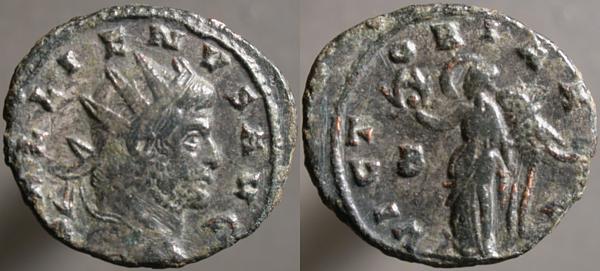
GALLIENVS AVG, Radiate head right | VICTORIA AVG, Victory standing left, raising wreath left. B in left field.
I try to only upgrade from an inferior coin to one that's so nice that I'll never feel the need to upgrade it again, since every purchase that needs an upgrade is, ultimately, wasted money. Sometimes, though, what I've got is so poor that I can't resist the immediate intermediate upgrade. This replaces a very worn example, and I look forward to improving it one day.
Update: (which isn't to say that I don't appreciate the wonderfully expressive face on this.)
Sunday, November 14, 2004
Æ26, Heracleia Pontica in Bithynia, Gallienus, Lindgren III, 177
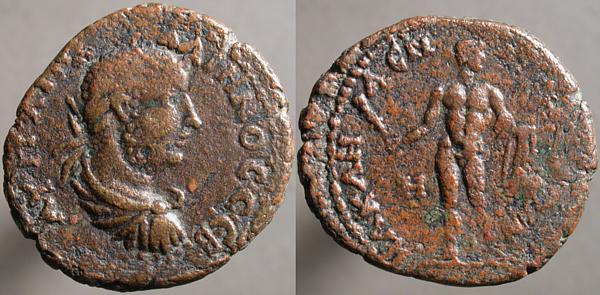
ΑΥ Π ΛΙ ΓΑ_ΛΛΙΗΝΟC CΕΒ, Laureate draped cuirassed bust right | ΗΡΑΚΛΗ_Α Ν[ΕΟΚΟ], Herakles standing facing, head left, holding club left and kion skin and bow right. Η in left field.
As the city was named for him, Heracleia Pontica favored Herakles on their coins.
This coin appears to have been struck from the same obverse die as that (see them together), and both are marked Η on the reverse, making them 8-assaria pieces.

